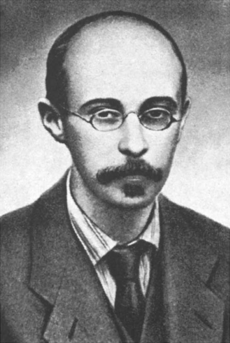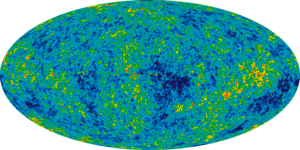Alexander Friedmann facts for kids
Quick facts for kids
Alexander Friedmann
|
|
|---|---|

Alexander Friedmann
|
|
| Born |
Alexander Alexandrovich Friedmann
June 16, 1888 |
| Died | September 16, 1925 (aged 37) |
| Nationality | Russian |
| Alma mater | St. Petersburg State University |
| Known for |
|
| Spouse(s) | Natalia Malinina |
| Scientific career | |
| Fields | Mathematics and physics |
| Institutions | Petrograd Polytechnical Institute Main Geophysical Observatory |
| Doctoral advisor | Vladimir Steklov |
| Doctoral students |
|
| Signature | |
| Physical cosmology | ||||||||||||||
 |
||||||||||||||
| Universe · Big Bang Age of the universe Timeline of the Big Bang Ultimate fate of the universe
|
||||||||||||||
Alexander Alexandrovich Friedmann (born June 16, 1888 – died September 16, 1925) was a smart Russian and Soviet physicist and mathematician. He is famous for his big idea that the universe is growing bigger. He created special math problems, now called the Friedmann equations, to explain how the universe works.
Contents
Early Life and Education
Alexander Friedmann was born in Saint Petersburg, Russia. His father was a composer and ballet dancer, and his mother was a pianist. Alexander was baptized into the Russian Orthodox Church when he was a baby.
He studied at St. Petersburg State University and earned his degree in 1910. After that, he started teaching at the Saint Petersburg Mining Institute. From his school days, he was best friends with Jacob Tamarkin, who also became a famous mathematician.
Serving During World War I
During World War I, Friedmann joined the army for Imperial Russia. He was an army aviator, which means he flew airplanes. He also worked as an instructor, teaching others how to fly. Later, he became the head of an airplane factory.
Discovering the Expanding Universe
In 1922, Friedmann shared his amazing idea: the universe is not still, but it is actually getting bigger! This means everything in space is moving away from everything else.
At first, even Albert Einstein, a very famous scientist, didn't believe this idea. Einstein thought the universe was always the same size. But a few years later, in 1926, another scientist named Edwin Hubble found proof. He saw that galaxies far away were moving away from us faster than closer ones. This observation is known as Hubble's law.
In 1927, a Belgian astronomer named Georges Lemaître also came up with the same idea of an expanding universe, without knowing about Friedmann's work. Friedmann's ideas helped explain how the universe began with the Big Bang and how it continues to grow.
In June 1925, Friedmann became the director of the Main Geophysical Observatory in Leningrad. He even took part in a record-breaking balloon flight, going up very high, about 7,400 meters (24,278 feet)!
Friedmann's Important Work
Friedmann's work in 1924 showed that he understood how the universe could have different shapes. He described three possible models for the universe:
- One where space curves like a ball (positive curvature).
- One where space is flat (zero curvature).
- One where space curves like a saddle (negative curvature).
These ideas became very important for understanding how the universe works. His work helped create the main models for both the Big Bang theory and the Steady State theory. The Big Bang theory says the universe started from a very hot, dense point and has been expanding ever since. The Steady State theory said the universe was always expanding but always looked the same. When scientists found the cosmic microwave background radiation (leftover heat from the Big Bang), the Big Bang theory became the most accepted idea.
The math equations that describe a smooth and even universe are now called the Friedmann–Lemaître–Robertson–Walker metric, or FLRW. This name honors Friedmann, Georges Lemaître, Howard P. Robertson, and Arthur Geoffrey Walker, who all worked on these ideas.
Besides studying the universe, Friedmann was also interested in how liquids and gases move (called hydrodynamics) and how weather works (called meteorology). Some of his students became famous physicists too, like George Gamow.
Personal Life and Passing
In 1911, Alexander Friedmann married Ekaterina Dorofeeva, but they later divorced. In 1923, he married Natalia Malinina. Even though they were not very religious, they had a religious wedding ceremony.
Sadly, Friedmann died on September 16, 1925. He got sick with typhoid fever, which was not correctly diagnosed at first. It is believed he caught the illness after eating an unwashed pear he bought on his way back from his honeymoon in Crimea.
Legacy
- A crater on the Moon is named Fridman in his honor.
- There is a regular science meeting called the Alexander Friedmann International Seminar. Scientists from all over the world meet to talk about space, gravity, and the universe. The first meeting was in 1988, celebrating 100 years since his birth.
- During protests in China in 2022, students at Tsinghua University showed Friedmann's equations. This was a clever way to protest, because "Friedmann" sounds like "free man" in English, and the idea of an "expanding universe" could mean opening up and becoming more free.
See also
 In Spanish: Aleksandr Fridman para niños
In Spanish: Aleksandr Fridman para niños

